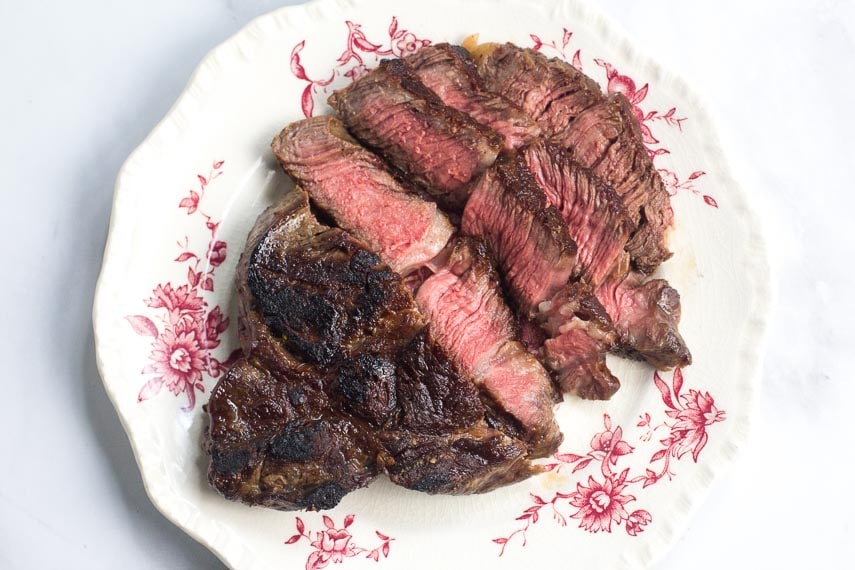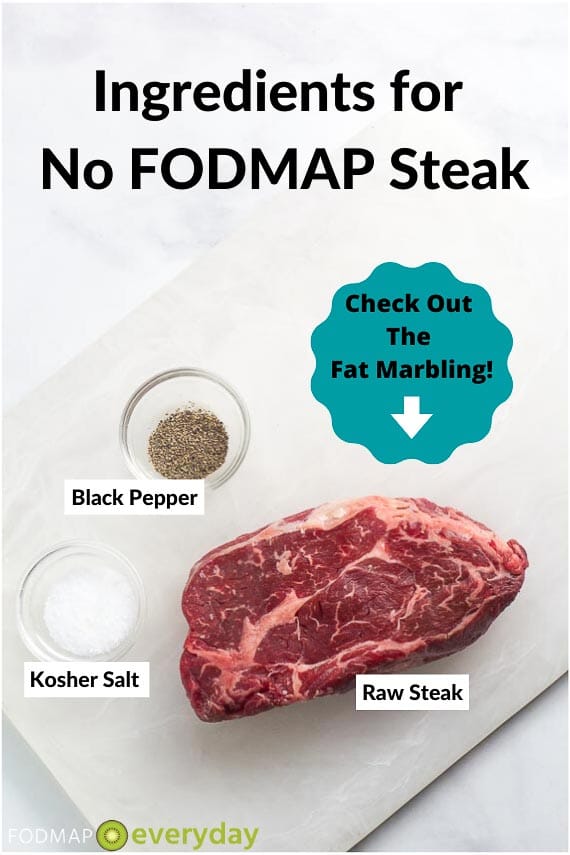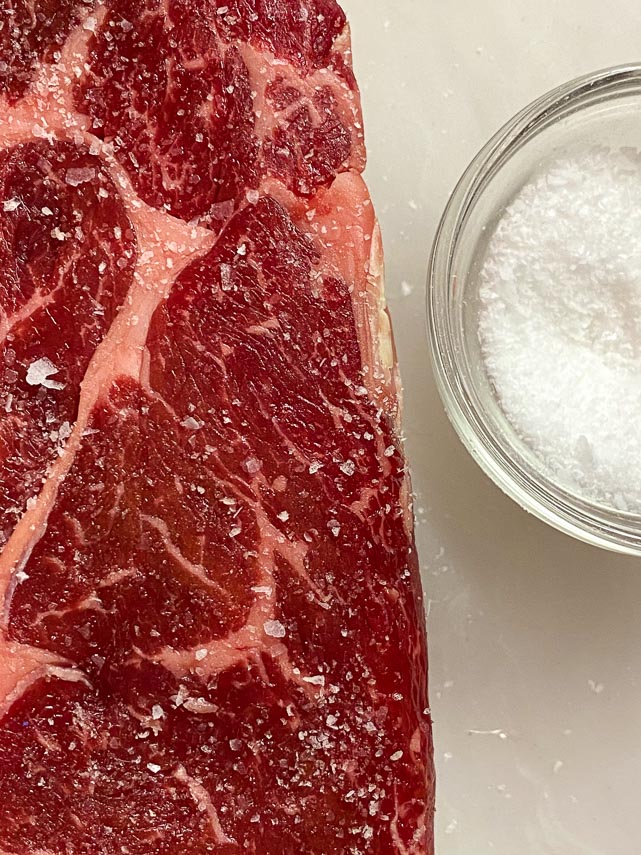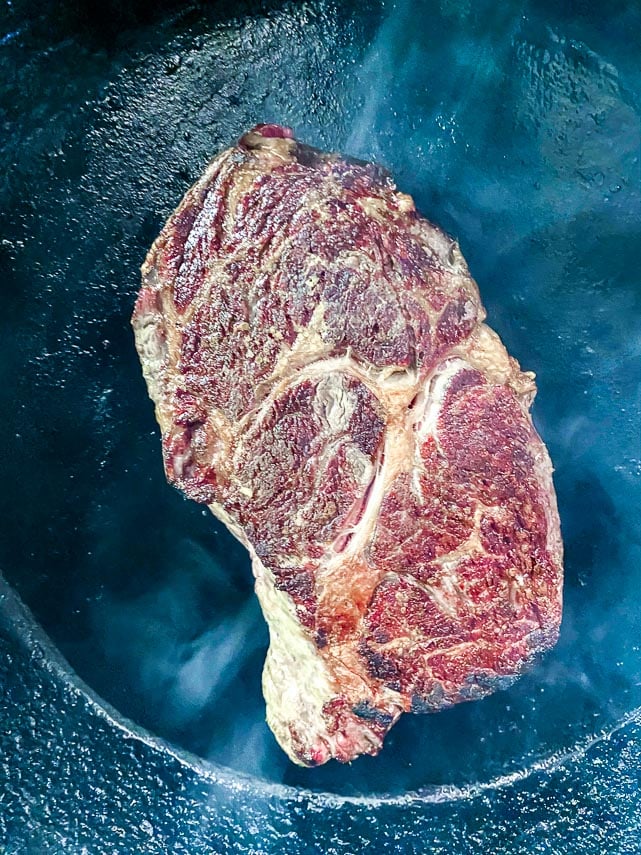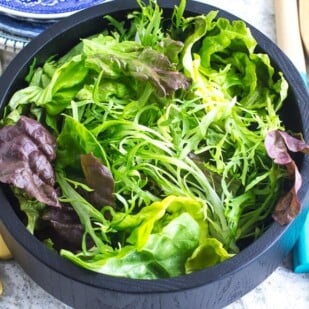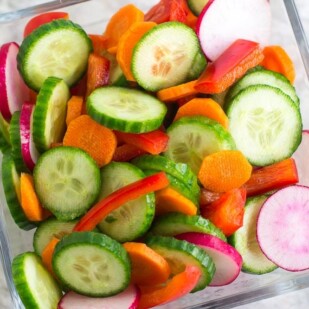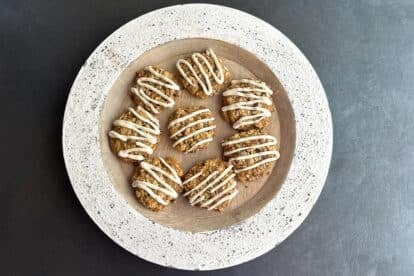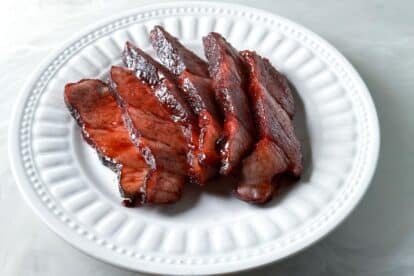We make this recipe for No FODMAP Steak often and want to share it so that you could incorporate it into your meal planning. Steak, being a pure protein, contains no FODMAPs. A little salt and pepper and BAM you’ve got a no FODMAP main dish. Serve with no FODMAP rice or baked potato and either our no FODMAP leafy green salad or no FODMAP crunchy vegetable salad.
How To Choose A No FODMAP Steak
There are many cuts of meat that will make a great no FODMAP steak eating experience and then there is also how the beef was raised to consider.
Here are some basic guidelines to keep in mind while steak shopping:
- Color: The meat should have rich, red color and appear moist but not wet.
- Shape: Whatever cut you are considering, it should be neatly presented with cleanly and evenly cut edges.
- Texture: The meat should feel firm to the touch and never mushy.
- Marbling: Some cuts are leaner than others; well-marbled steak (fat streaks) will yield the best flavor and texture.
- Pre-packaged: We prefer going to the butcher case, but if you have to buy pre-packaged make sure the package is sealed tightly and avoid any with liquid in the bottom of the tray.
What Kind Of Steak Do You Like?
Some folks like to be able to cut their steak with a butter knife, or even just with a fork, while others want some chew and heartiness. How you are going to cook your steak will dictate what kind you buy as well, but here are some general guidelines:
Grilling & Pan Roasting Steak: We are partial to top loin, ribeye, T-bones and Porterhouse. Sirloin can work too, but as it is fairly lean, keep an eye on it. Skirt steak, flank steak and tri-tip are also great for grilling but will be greatly improved if marinated.
Tender Steak Fans: Beef tenderloin and filet mignon (the short end of the tenderloin) are the best choices if tenderness is your goal.
Special Occasions: Though pricey, Porterhouse, T-bone, beef tenderloin, filet mignon, ribeye and Tomahawk (ribeye with bone attached) steaks are fantastic choices when money is less of an object and you want richness and maximum flavor.
All About Grass-Fed Beef
When you shop for your steak you might be presented with a choice between grass-fed beef and “regular”. The point is, that if the cow has been solely grass-fed, you will be alerted, as it will also have a higher price tag. If it doesn’t say anything, then it is most likely grain finished.
Here are the differences:
Grass-Fed Beef: True grass-fed beef means that the cow has spent its entire life on grass. Grass fed beef tends to be leaner, as a generalization. Many meat lovers prefer grass-fed.
Grain-Fed Beef: All cows begin grazing on grass in the pasture. A short time after weaning, the young cows are then “finished” (that’s the industry term) on grain, usually corn, which helps them gain weight fast and produces lovely marbling.
Whether grass-fed or grain-fed beef is better for the environment and/or animal welfare is a complex issue and not one that we are focusing on here. This article from NPR does a great job at addressing these issues.
Whichever way you go, know that the leaner grass-fed can cook more quickly.
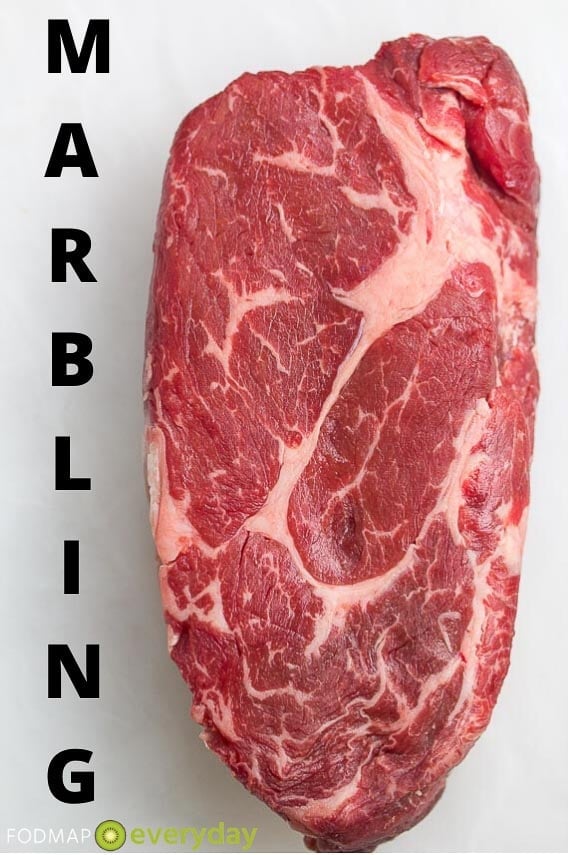
Pan Searing
While I love a good grilled steak, made over hardwood charcoal, the fact is that if it is midweek and I need dinner in a hurry, pan searing in a cast-iron pan is a great way to go. That is what this recipe is all about.
Cast Iron Pan
There are a few types of pans that will truly make a difference in your cooking. I could not produce the fine food that I do without my triple-ply aluminum pans, my enameled cast-iron and my cast-iron pans.
Cast iron heats beautifully – evenly and holds heat – and is exceptional for searing a steak. I love the pre-seasoned Lodge pans. They are a great price-point and very well made.
Ingredients for No FODMAP Steak
Cast Iron Pan – I know this is a piece of equipment, but it makes a difference!
Steak – Choose your meat! The cut in the image is a ribeye.
Salt – Use kosher salt and season before cooking. We use Diamond Crystal brand and far prefer it over other brands such as Morton’s. Read more here.
Pepper – Freshly ground please.
How To Make Pan-Seared No FODMAP Steak
Season your steak with kosher salt.
Preheat your cast-iron pan (or other heavy pan) over medium-high heat. Add the steak – you should hear sizzle! – and turn heat down to medium.
Cook the steak until it gets a nice sear on the bottom…
Then flip over and cook second size until it develops a nice crust and is cooked to your liking. Allow to rest briefly, season with salt and pepper, then carve against the grain and serve.
USDA Safe Meat Temperatures
OK we have to address the elephant in the room. The USDA recommends that you cook all whole cuts of meat, including pork, to an internal temperature of 145°F (63°C)and then allowing a 3-minute rest. In our personal culinary opinion, this is going to lead to a lot of overcooked meat.
Now, all of us have a GI tract with issues, and eating undercooked meat is not recommended for anybody, let alone someone with digestive problems. BUT. And this is a huge but, this is also the reason you see statements on the bottom of restaurant menus alerting diners to the fact that eating raw or undercooked meat is not recommended. And then, what happens? Many people order rare and medium rare meat, me included.
So, be aware of what is considered safe and recommended. Know how you like your meat cooked and make an informed decision. I have always liked what Weber says on their website: they use the terminology “chef standards” vs. USDA recommendations. Ask any chef if they like medium well done or well-done meat and get ready for an earful.
How To Assess Doneness
Here is a chart. Use an instant read thermometer, insert into the center of the steak, and understand that the internal temperature will increase upon resting off of the heat.
Rare: 120°F to 125°F (about 52°C)
Medium Rare: 125°F to 130°F (about 57°C)
Medium: 135°F to 145°F (about 63°C)
Medium Well: 145°F to 155°F (about 66°C)
Well Done: 155°F + (about 70°C)
Testing Doneness Without A Thermometer
There is a way to use your own hands, literally, to assess doneness of meat. No thermometer needed.
Raw Meat: Open one of your hands and have it in a relaxed state. Use a finger from the other hand to press into the fleshy party of your hand just below the thumb. It should feel mushy, just like raw steak. Check this out next time you have a raw steak around.
Rare Meat: Now gently touch your index fingertip and thumb-tip together. Press that same fleshy area again. It will feel a little firmer. This is the texture of rare cooked meat.
Medium Rare: Repeat the above process using your middle finger instead of your index finger. The fleshy part is firmer still and represents the “give” of medium rare cooked meat.
Medium: Move on to your ring finger to get a “medium” texture.
Well Done: For well done, touch the tip of your pinky to your thumb and do the test. The fleshy part beneath your thumb will be quite firm, just like well-done meat.
Now that you know what your hand feels like, press the meat as it is cooking with your finger and try to assess which hand texture the meat corresponds to, to gauge doneness.
How Long Do You Cook Steak?
This is a complex question! It is going to depend on the size of your steak – its width and depth – whether it is grass-fed or not, how cold the meat is when it hits the pan, how well your pan conducts heat and hot how the pan is.
Cooking a great steak becomes easier with experience. Use the visual and textural cues above – and get an instant-read thermometer if you want even more help.
Make sure to visit our other No FODMAP recipes to help you build your meals throughout the days and weeks:
- No FODMAP Vegetable Salad
- No FODMAP Baked Potato
- No FODMAP Fruit Salad
- No FODMAP Malt Vinegar Salad Dressing
- No FODMAP Leafy Green Salad
- No FODMAP Rice
- No FODMAP Chicken Paillard
- No FODMAP Cod
- And if you want to branch out a bit, try our Low FODMAP Steak Sauce.
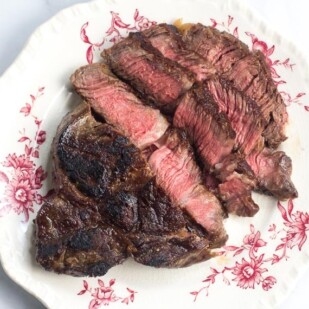
No FODMAP Steak
Our No FODMAP Steak is quick enough for a last minute dinner and perfect alongside our No FODMAP Baked Potato and No FODMAP Leafy Green Salad.
Low FODMAP Serving Size Info: Serves 2 to 4 people
Ingredients:
- 2, 8- ounce (225 g each) ribeye steaks, at a cool room temperature
- Kosher salt
- Freshly ground black pepper
Preparation:
-
Season your steaks with salt. Preheat your cast-iron skillet over medium-high heat. Add the steaks and you should hear a nice sizzle! Allow to cook undisturbed until a nice sear forms and the meat begins to cook through on that side. Flip over and continue to cook to desired doneness.
-
Remember that if you want Medium Rare steak at about 130°F (55°C), pull it off the heat when it hits about 125°F (52°C) as the internal temperature will rise upon sitting off of the heat.
-
Slice against the grain and serve. Consider serving with no FODMAP rice or baked potato and a nice no FODMAP leafy green salad.
Notes:
Tips
- The serving size is variable. This is because this recipe contains no FODMAPs and a generous serving can be enjoyed. That said, many people with IBS also have issues with fat and rich food, in which case a smaller serving size would be prudent. Eat to your own tolerances.
Nutrition
All nutritional information is based on third-party calculations and should be considered estimates. Actual nutritional content will vary with brands used, measuring methods, portion sizes and more. For a more detailed explanation, please read our article Understanding The Nutrition Panel Within Our Recipes.
